



“An Act Relating to the Town of Dartmouth”, 1923 c73
Amicitia Crescimus




“An Act Relating to the Town of Dartmouth”, 1923 c73
“An Act Relating to the Town of Dartmouth”, 1922 c65












“An Act Relating to the Town of Dartmouth”, 1921 c93

“Dartmouth Gas and Electric Light and Heating and Power Co., Ltd.; Act to amend c132, Acts 1899, incorporating”, 1920 c181










“An Act Relating to the Town of Dartmouth”, 1920 c106
From The Story of Dartmouth, by John P. Martin:
In 1920 we had the coldest winter for years. There were 21 days of good sleighing, and 11 days of sub-zero weather in January with the mercury down to 17 below near the month-end. In February the harbor froze over for the first time since 1898. The ferries kept a lane open, and the tug “Ragus” bucked her way daily from the Sugar Refinery to the Imperial Oil wharf at Halifax. On a Sunday afternoon, a number of us skated from Mill Cove to McNab’s Island, without experiencing any difficulty except in hopping over the ice-pans in the channel of the “Ragus” off Woodside.
Robert Lynch, who had been eight years in the Town Council, opposed Dr. Simpson in the Mayoralty election and got 525 votes to the Doctor’s 617. A motor-driven ladder truck was purchased and the first Town Engineer appointed in the person of H. E. R. Barnes. The Dartmouth Housing Commission was organized with J. J. O’Toole as Chairman. Other members were James A. Redmond, Albion B. Smith, George Mitchell and Ralph W. Elliot.
The Dartmouth Amateur Athletic Association was organized in March with a membership of nearly 400, and secured a 21-year lease of the Chebucto Grounds. Leo Graham was the first President. About that time an 8-page newspaper called “The Independent” was started by Arthur Johnston, son of A. C. Johnston. The Halifax Institute of Engineers now reported that an overhead bridge across the harbor was impracticable, and suggested a low-level drawbridge to accommodate rail and other traffic. The cost was $2,000,000. “The Independent” thought this decision a fortunate one, stating that if people had to wait for a $10,000,000 overhead bridge, “they would be still waiting when the new millennium dawned”. The Ferry Commission in February passed a resolution recording, “its hearty appreciation of the efforts of the Halifax-Dartmouth Bridge Committee, with the hope that their efforts would be crowned with success”.
Ex-Councillor John Ritchie died that spring, as also did James W. Tufts a member of the Dartmouth Park Commission continuously since 1891. Another prominent citizen to pass away was ex-Mayor Edward F. Williams. He had served as Chief Magistrate for a total of eight years, having previously sat six terms as a Councillor.
We got our first piece of permanent road on this side of the harbor in 1920 when Cavicchi and Pagano paved the stretch from the town limits to Horton’s Brook at Imperoyal. It was one of the first sections of permanent-surfacing completed by the Highway Department in the whole Province, and was commenced a few months before the local election. Considerable credit for this undertaking should go to Hon. Robert Finn, a former Dartmouthian, who was always alert to the interests of his constituents in eastern Halifax County
The work of rehabilitating explosion-damaged houses was just about finished up that summer. The stone Downey house on Coleman Street, built by Joseph Moore in early Canal days, was so badly shaken that it had to be demolished. More new residences went up in the north-end, also in Austenville, in Hawthorne-Sinclair Street sections, on Elliot Street, on upper Portland Street, in the Charles Harvey subdivision at Prince Arthur’s Park and on Rodney Road.
Falconer’s field was subdivided by Engineer J. Lorne Allan, and streets there were named for ex-Mayor Williams and Dr. M. S. Dickson. Sewerage and water pipes were extended to new houses on Elmwood Avenue, which had just been cut through the former Torrens field. At Manor Hill, where Andrew Shiels once wrote poetry the Eastmount subdivision of S. A. Heisler was selling lots as low a $100. Streets were named for military leaders in World War I.
The yearly report of the Housing Commission showed that 21 dwellings in Dartmouth were erected with their loans, on as many vacant lots. The Canadian Bank of Commerce opened a branch at the northeast corner of Portland and King Streets. Laurie Bell was now operating a small garage on the location of the present Police Station. The new Grace Methodist Church was completed and dedicated on Sunday, November 14th. South of the Church on King Street, Dartmouth’s second fire-engine house was torn down. This was an ordinary-sized shed in which were stored the watering cart and the antique fire-engine, pumped by hand. A valuable tourist attraction was lost when this relic was later sold for junk.
The school enrolment that year was 1,628. Grover C. Beazley joined the teaching staff to assist Principal Stapleton and Miss Findlay at Park High School where a class in Grade 10 was established in 1920. The Manual Training branch was abolished, and the work room converted into a shooting gallery for the cadet corps.
Ferry receipts fell and expenditures increased during 1920, for the second year in succession the Commission suffered a deficit. That year they went behind nearly $18,000.
The first electric street lights of Dartmouth were strung diagonally so that the light was suspended in the middle of intersections. In a wind-storm, the saucer-shaped disc rocked, swayed and almost turned turtle.
Central School served the Town for half a century until rendered uninhabitable by the 1917 Explosion, although the roof still remained tight. After that, the BBCA converted two upstairs rooms into a gymnasium for basketball and used it up to the time that the old landmark was demolished about the year 1922.
Henry Y. Mott, grandson of his namesake, who had left here in the 1870s for St. John’s, Nfld., occasionally contributed reminiscent letters to the Dartmouth newspaper. About this time another one appeared giving a list of members of the “Cabbage Club” which flourished in his youth, and included names like Charles and Harry Harvey, Edwin George and W. H. Sterns, Dr. Fred Van Buskirk, Charles Young, John Brown, Albert Wisdom, Fred Hardenbrook, W. C. Mott, W. H. Stevens, Alpin Bowes, Fred Bowes and others.
One of their popular events was the sleigh drive out to Griffin’s Inn on Preston Road, whither they were conveyed in teams supplied by W. H. Isnor, W. H. Greene or John Myers. “I saw Henry Isnor two or three years ago”, wrote Mr. Mott, “and found the patriarchial John Myers, white whiskered and bearing the marks of time, but in spirit as vivacious as a colt and possessing the old time fondness for his horses”.
The writer then commented on the changes in and about Dartmouth, noting that there was little left of many familiar scenes of his boyhood except the memory. “What Dartmouth boy of 50 years ago”, concluded Mr. Mott, “does not remember Mrs. Roberts’ taffy shop near the bridge (NW corner Victoria Road and Portland) and with what joy the treasured cent was expended. Then there was Mrs. Morrissey whose spruce beer, cakes and other juvenile attractions were sold in a little shop opposite the present palatial store of L. Sterns and Son. Could the old blacksmith forge of my friend John D. Murphy speak, what tales of deviltry and mischief would be revealed, of tricks played upon the citizens of Preston on market days, and indeed upon many other unfortunates who came under the spell of those who had not quenched the fiery vengeance of youth”.
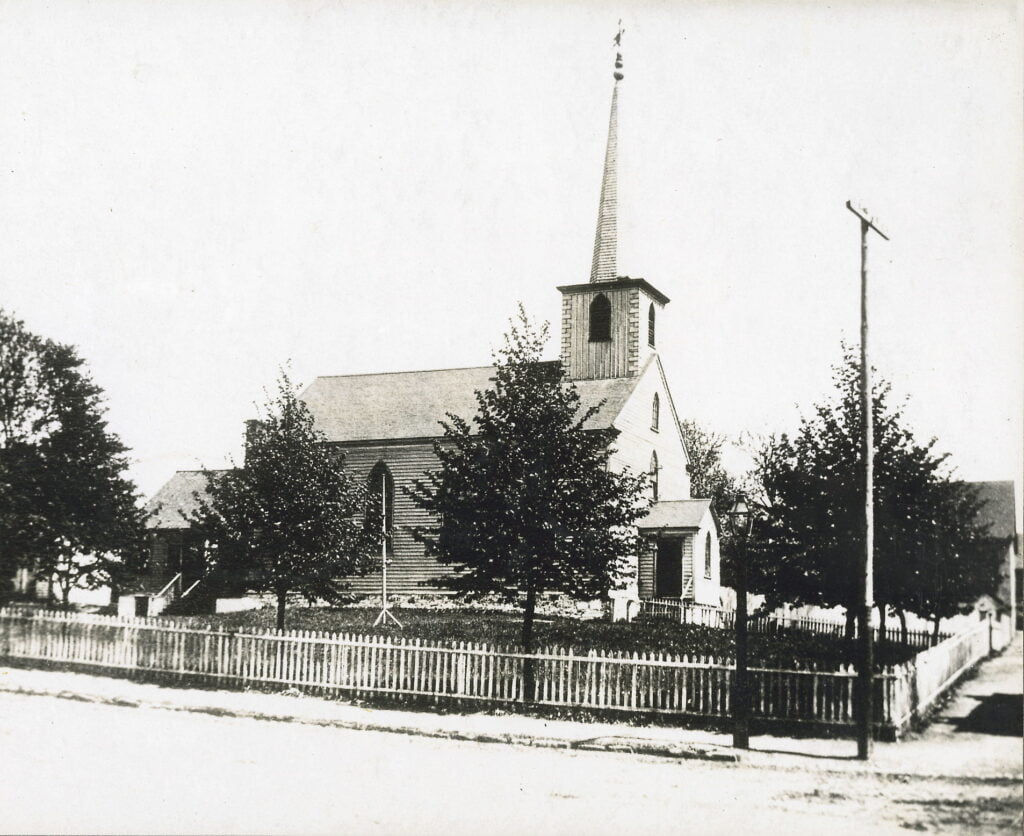
“Old St. Peter’s chapel, 1830-1893, cor. of Ochterloney St. & Chapel Lane, Dartmouth, N.S. View looking east, photographed about 1890. It was re-erected in 1830 from the frame, &c., of the original St. Peter’s Chapel, built in 1784 close to present site of St. Mary’s Cathedral, near corner of Barrington St. & Spring Garden Road, Halifax. The steeple was built on the Dartmouth St. Peter’s in 1831 or very soon after. At right, Chapel Lane, gate to church, Quarrel (Queen) Street extreme middle right. Oil street lamp seen front right on Ochterloney Street, at middle left is the Priests’ house.” https://archives.novascotia.ca/photocollection/archives/?ID=5302

“The chapel was demolished (̶a̶b̶o̶u̶t̶ ̶1̶9̶2̶6̶ ?)” …🤔
The original church was located at the corner of Ochterloney and Edward Street, this part of Edward Street between Ochterloney and Queen was once known as “Chapel Lane“. This site in more recent times was home to a Tim Horton’s, which has since been demolished. Today the site is a parking lot.
From The Story of Dartmouth, by John P. Martin:
This is what the old Church looked like about 1890. Commenced in 1829, the steeple and attached glebe house were not erected until some years later. The vertical dark line in the picket fence at the Chapel Lane entrance is a turnstile. There is another barely discernible at the northwest corner of the Church. From there, a path led to Ochterloney St. Turnstiles were common sights, because gardens had to be protected from marauding cattle.
The trees were planted in Father Geary’s time, and solicitously watched over by Thomas Gentles, senior, whose house was to the left of the picture. Just left of the telephone pole, is seen a diamond-shaped glass case surmounting a shorter post. Inside the case was an ordinary kerosene lamp. That constituted our street lighting system... The original St. Peter’s Church was demolished in 1893.
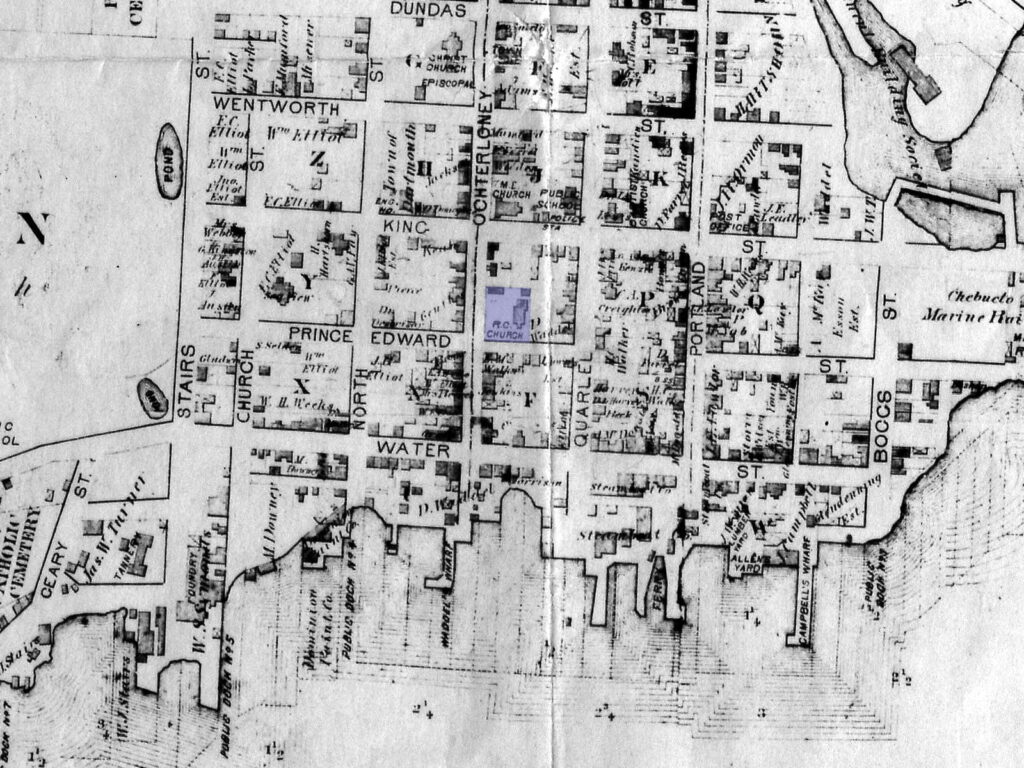
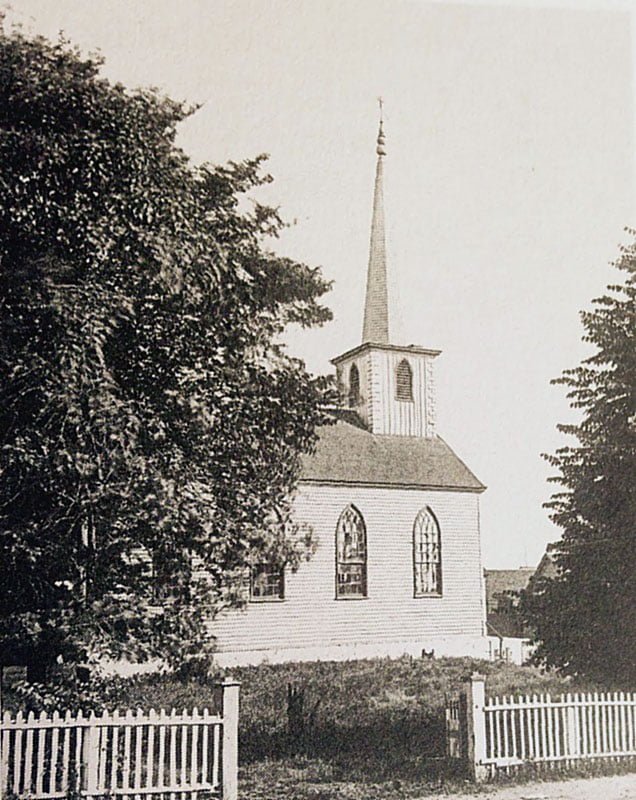
From the Acadian Recorder in 1829:
“On Monday the frame of a new Catholic chapel was raised, in this delightfully situated little village. The caulking of the Steam Boat was nearly completed, and she appears about ready for her machinery; piles are driving, and repairs making at the wharf intended for her use. Considerable animation seemed to pervade every quarter, which made the town appear very attractive. We are glad to witness indications of improvement in Dartmouth; we augur that (before) long it will increase rapidly in size and value. Independent of its being the outlet for the Shubenacadie Canal, it has many attractions which must operate favorably on her circumstances accordingly as Halifax improves. With a south-west aspect; sheltered from keen north and east winds by hills; enjoying a delightful sea scene and breeze, possessing romantic walks along the shores, and through the surrounding very picturesque country; having the retirement of country life, with the convenience of being divided from the metropolis by not more than a ten minute sail; we think that Dartmouth to the invalid and to many other classes holds out particular inducements as a place of residence. We are too apt to overlook the advantages lying close at our hand, searching for those which, not better, are more distant and costly.”
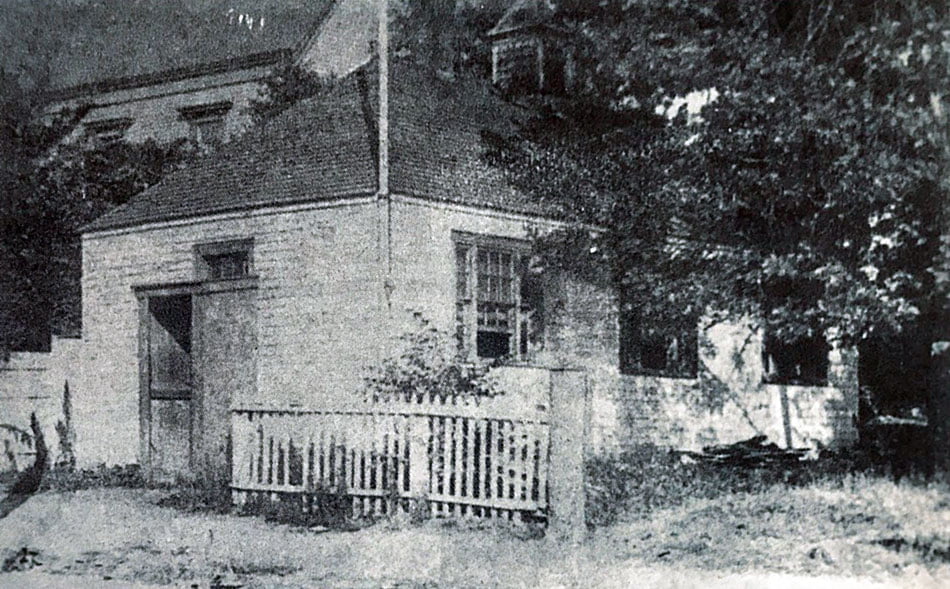
St. Peter’s hall, seen above, was leased to the town for classroom space to supplement new Central School. It was known as “Miss O’Toole’s school.” This building is still standing — though it was moved — it’s now located on Oakdale Crescent, where for a period of time it served as the neighborhood corner store.
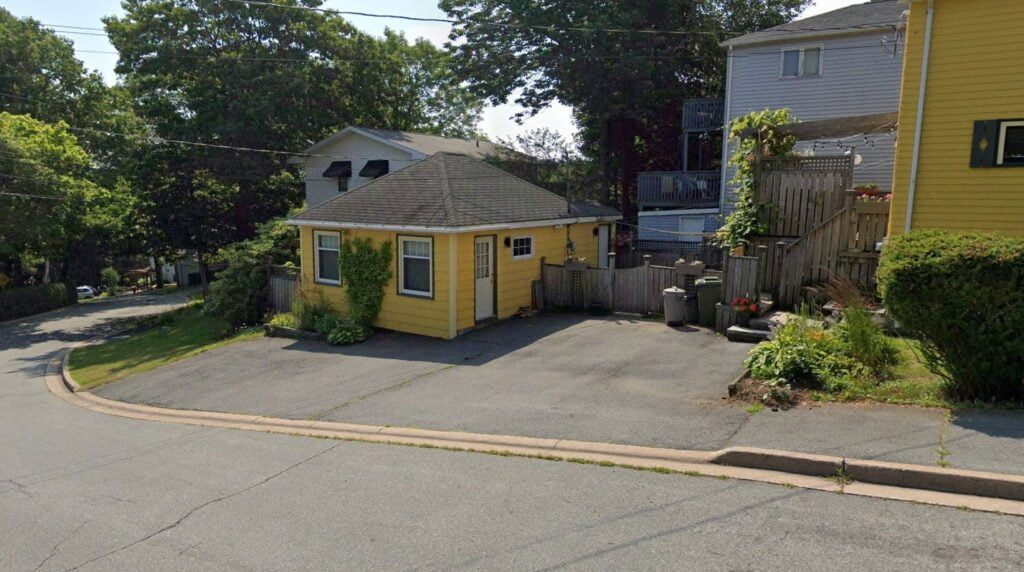
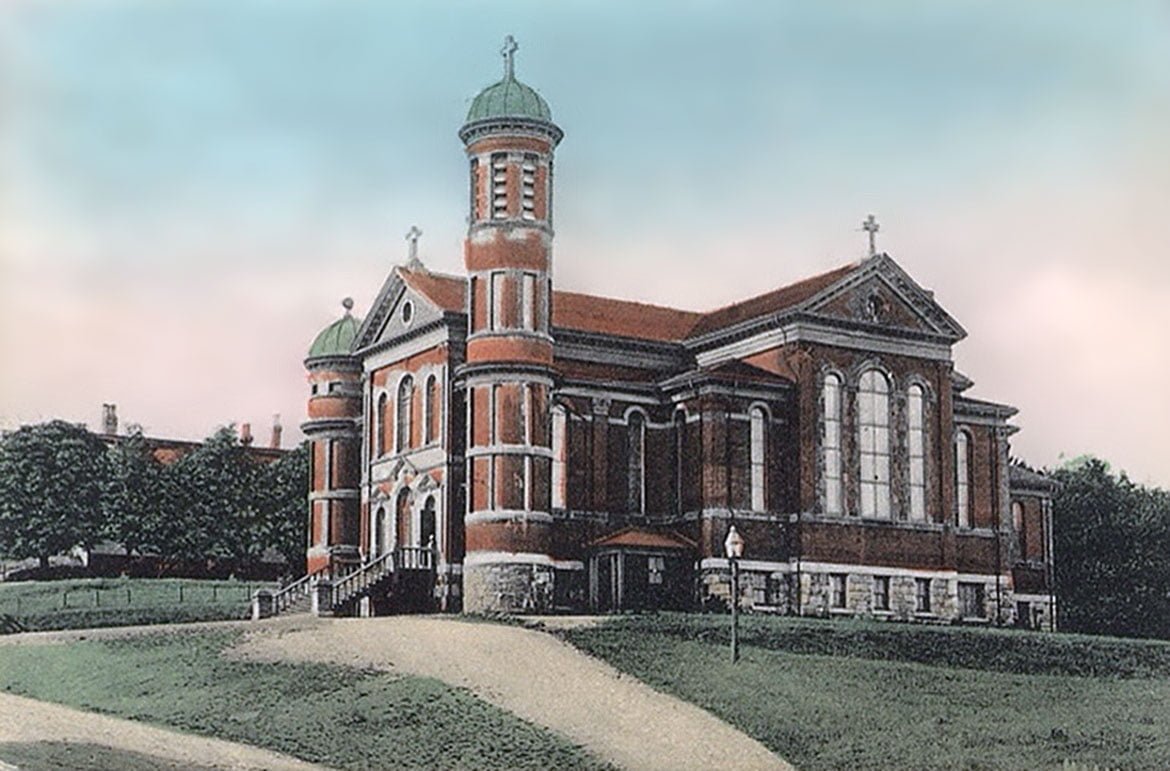
The corner stone of the new St. Peter’s Church seen above was laid on July 2, 1891 and dedicated on July 7, 1901.

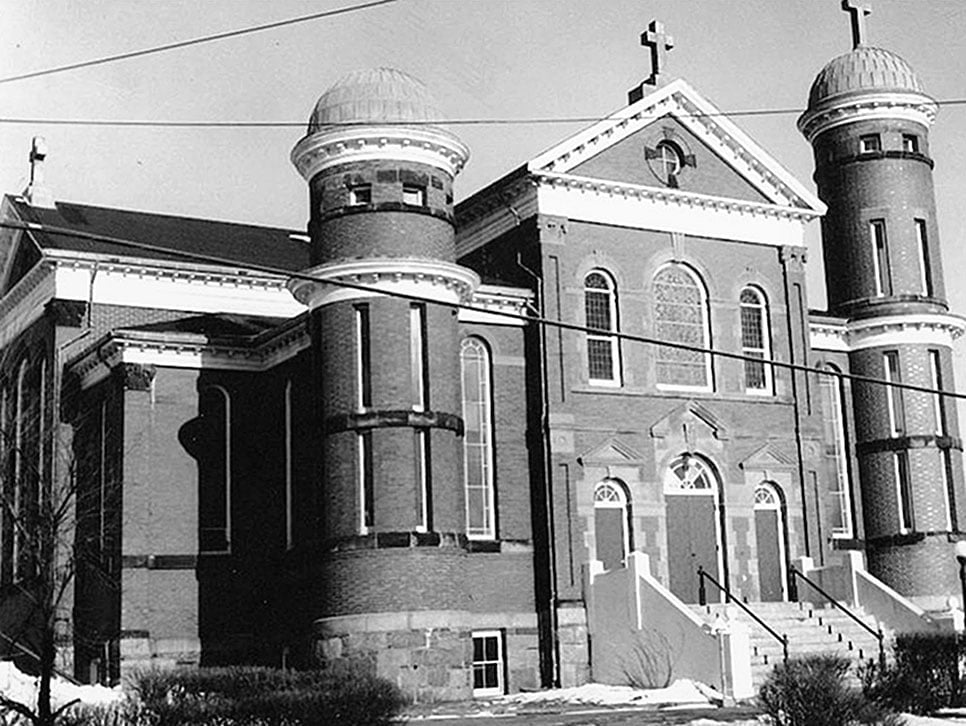
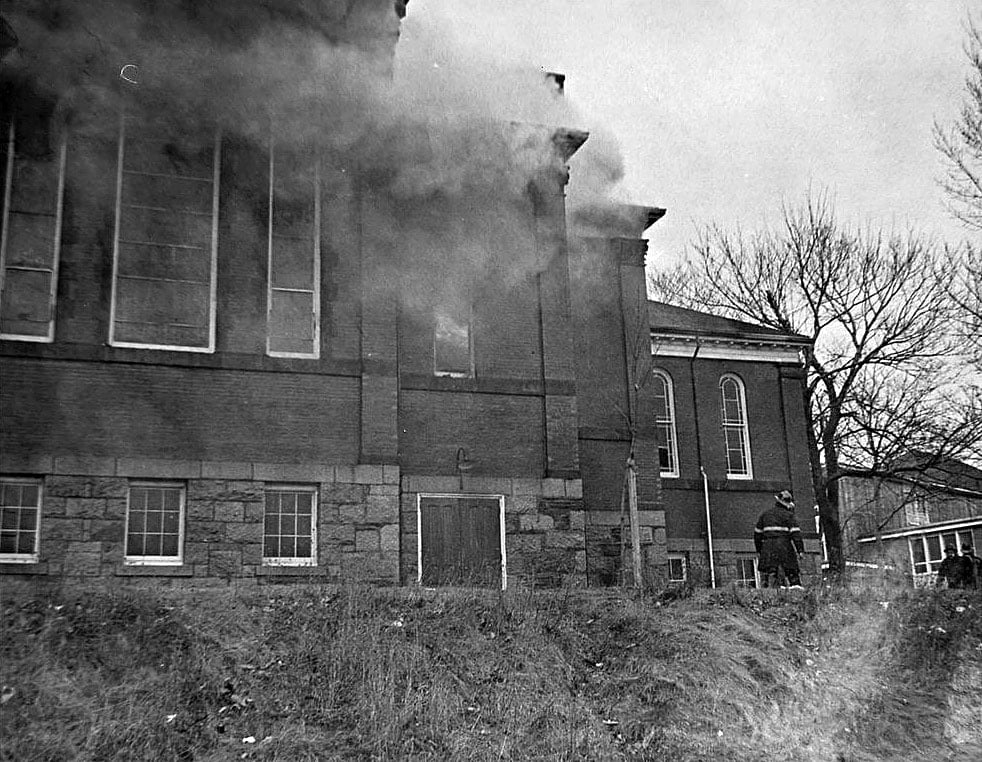
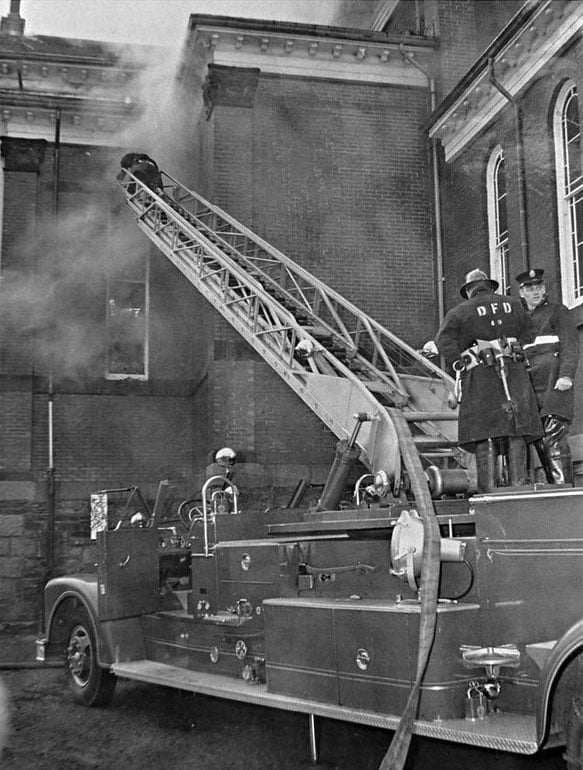
St. Peter’s Church fire, December 28, 1966.
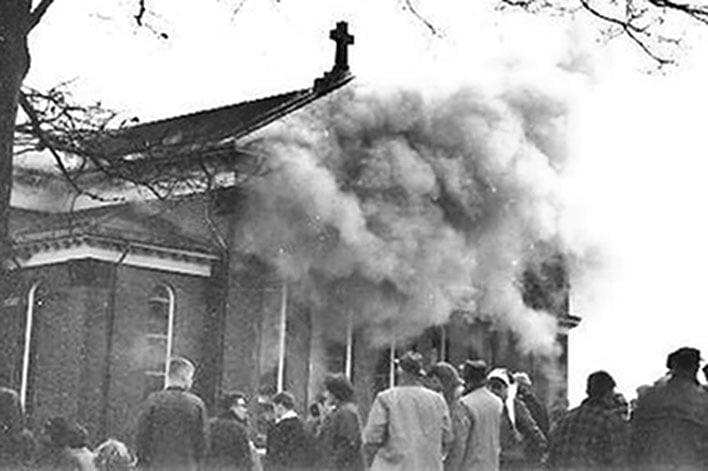
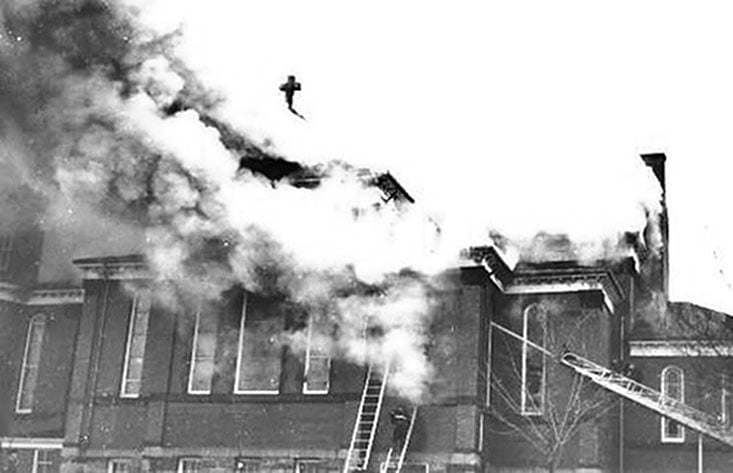
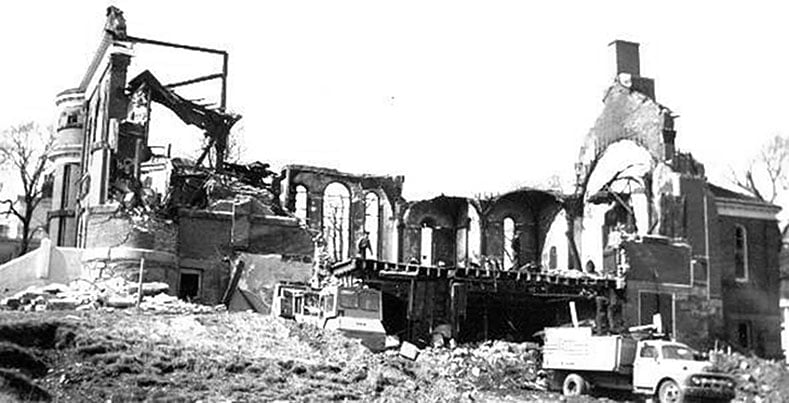
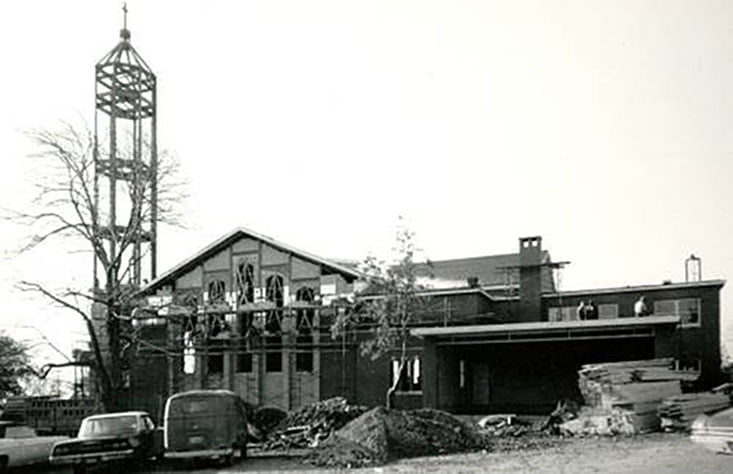
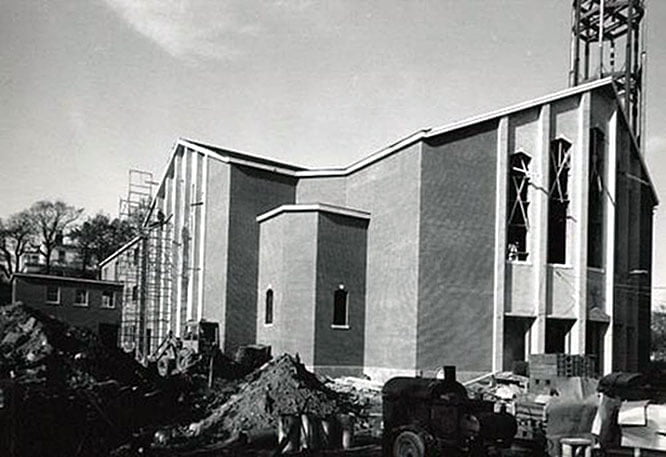
The third St. Peter’s Church under construction, completed in 1969, consecrated on June 29th of that year.
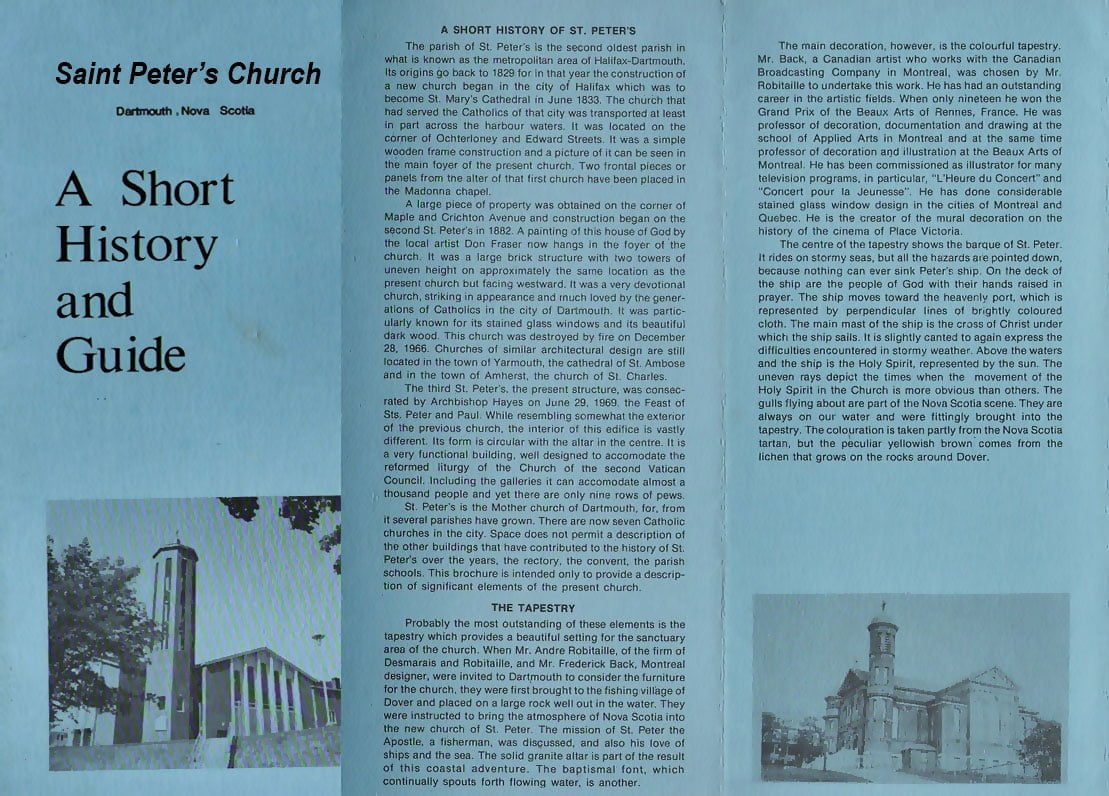
A Short History of St. Peter’s: The parish of St. Peter’s is the second oldest parish in what is known as the metropolitan area of Halifax-Dartmouth. Its origins go back to 1829 for in that year the construction of a new church began in the city of Halifax which was to become St. Mary’s Cathedral in June 1833. The church that had served the Catholics of that city was transported at least in part across the harbour waters. It was located on the corner of Ochterloney and Edward Streets. It was a simple wooden frame construction and a picture of it can be seen in the main foyer of the present church. Two frontal pieces or panels from the altar of the first church have been placed in the Madonna chapel.
A large piece of property was obtained at the corner of Maple and Crichton Avenue and construction began on the second St. Peter’s in 1882. A painting of this house of God by the local artist Don Fraser now hangs in the foyer of the church. It was a large brick structure with two towers of uneven height on approximately the same location as the present church but facing westward. It was a very devotional church, striking in appearance and much loved by generations of Catholics in the city of Dartmouth. It was particularly known for its stained glass windows and its beautiful dark wood. This church was destroyed by fire on December 28, 1966. Churches of similar architectural design are still located in the town of Yarmouth, the cathedral of St. Ambrose and in the town of Amherst, the church of St. Charles.
The third St. Peter’s, the present structure, was consecrated by Archbishop Hayes on June 29, 1969, the Feast of Sts. Peter and Paul. While resembling somewhat the exterior of the previous church, the interior of this edifice is vastly different. Its form is circular with the altar in the center. Is is a very functional building, well designed to accommodate the reformed liturgy of the Church of the second Vatican council. Including the galleries it can accommodate almost a thousand people and yet there are only nine rows of pews.
St. Peter’s is the mother church of Dartmouth, for, from it several parishes have grown. There are now seven Catholic churches in the city. Space does not permit a description of the other buildings that have contributed to the history of St. Peter’s over the years, the rectory, the convent, the parish schools. This brochure is intended to provide a description of significant elements of the present church.
The Tapestry: Probably the most outstanding of these elements is the tapestry which provides a beautiful setting for the sanctuary area of the church. When Mr. Andre Robitaille, of the firm of Desmarius and Robitaille, and Mr. Frederick Back, Montreal designer, we’re invited to Dartmouth to consider the furniture for the church, they were first brought to the fishing village of Dover and placed on a large rock well out in the water. They were instructed to bring the atmosphere of Nova Scotia into the new church of St. Peter’s. The mission of St. Peter the apostle a fisherman was discussed, and also his love of ships and the sea. The solid granite altar is part of the result of this coastal adventure. The baptismal font, which continually spouts fourth flowing water, is another.
The main decoration, however, is the colorful tapestry. Mr. Back, a Canadian artist who works with the Canadian broadcasting company in Montreal, was chosen by Mr. Robitaille to undertake this work. He has had an outstanding career in the artistic fields. When only 19 he won the Grand Prix of the beaux arts of Renees, France. he was professor of decoration, documentation and drawing at the school of applied arts in Montreal and at the same time professor of decoration and illustration at the Beaux Arts of Montreal. He has been commissioned as illustrator for many television programs, in particular, he has done considerable stained glass window design in the cities of Montreal and Quebec. He is the creator of the mural decoration on the history of the cinema of place Victoria. The center of the tapestry shows the bark of St. Peter. It rides on stormy seas, but all the hazards are pointed down, because nothing can ever sink Peter’s ship. On the deck of the ship are the people of God with their hands raised in prayer. The ship moves towards the heavenly port, which is represented by perpendicular lines of brightly colored cloth. the main mast of the ship is the cost of Christ under which the ship sails. It is slightly canted to again Express the difficulties encountered in stormy weather. Above the waters and the ship is the holy spirit spirit, represented by the sun. The uneven race depict the times when the movement of the holy spirit in the church is more obvious than others. The goals flying about are part of the Nova Scotia scene. They are always on our water and we’re fittingly brought into the tapestry. The coloration is taken partly from the Nova Scotia tartan, but the peculiar yellowish Brown comes from the lichen that grows on the rocks around Dover.

Mr. Back took several samples home with him to Montreal and numerous photographs in order to obtain the correct shade. The weaving of the cloth was done by a Mrs. Thomas of Montreal and the stitching was done by several hands, but to a large extent, it is the work of Mrs. Back, wife of the designer.
The stained glass windows: The Resurrection
The three sets of large windows, a kind of triptych, make up a unified hole, representing, on the east side of the church the creation of life, over the front entrance the new, resurrected life, and on the West side the life of the body of Christ infused by the holy spirit. We just have the actions of the three persons of the trinity. The middle Windows depict the resurrection, the rising of Christ, the son of god, from the tomb to the new and eternal life. The artist gives us the early morning scene of the Easter event. To the left, near the bottom, there are the darker brown colors representing the tomb. Rising out of the tomb, there is the glorified figure of Jesus, in the bright gold and yellow colors, with the red indicating the scars of the crucifixion. Just as in the East windows, we have the creation of the human, so this Christ embodies us all in the recreation of humanity, the restoration of Divine Life. The sweep of this movement is reflected in the tapestry behind the presidential chair by the bark of Peter. Also, similar colors are used in the skillful work of art.
The Creation
The creation depicted in the windows on the east side has, as it’s dominant feature, the figure of mankind before the rejection of God’s will. It stands out and surmounts the rest of creation which has been designed, showing one layer or stratum of life superimposed on the other, suggesting The evolutionary aspect of God’s action. The six days of creation, as described in the first chapter of genesis, are well brought out. A great variety of colors is used to remind the viewer of the innumerable species of life. At the bottom of the windows, we have fossils and the remnants of prehistoric animals. Vegetable matter is suggested by the use of wheat and other plants. Various forms of animal life can also be seen, snakes, mollusks, snails, fish, etc. In the sky, as well, birds fly about, and knowingly expressing the beauty of God’s work. In the upper section, we may note other references to the story of creation, the separation of night from day, the dividing of the water from the land. A kind of spiritual dome, the heavens, surmounts this, giving us the strong feeling that this dynamic life force emanates from the Creator who said that “it was good”.
The Life of the Church
The windows on the west side, the creation of the church, while slightly resembling that of the creation of the world, are quite different. Here, there is more of a sense of movement, expressed by the sharpness of the lines, the shapes and vivid colors. The holy spirit, symbolized by the dove, tower is above all and envelops the whole with a protective aura, where the reds represent the fire, the zeal of love. Under the action of the spirit of god, the apostles respond with enthusiasm as they become the temples of God’s indwelling. They reach upwards to receive the Divine Life of grace, represented by the vertical and oblique lines which descend from above. The small dark pieces of glass, closely formed together suggest the multiplex technology of the modern world and indeed the great variety of people as well. the blue trapezium shapes can be visualized in two ways, they are openings in the heavens which they resemble by virtue of their blue color and these windows remind us that the church should not look inward but rather reach out and project toward the whole of humanity, responding to the words of Christ “go and teach All Nations”. Stained glass has been placed in two other areas of the church. In the Madonna chapel two events in the life of the blessed Virgin Mary have been depicted. In both cases the design is in keeping with the modern designs of the larger windows. On the right side is the immaculate conception with the suggestion of a lily while on the left of the chapel the quote assumption quote is portrayed describing a passage to eternal life near the Tabernacle and to the right are three small Windows which portray symbols of the Eucharistic Christ. Stocks of wheat and grapes from the vine are easily recognized in this unified scene. Mr. Beck has provided his recommendations and artistic knowledge for our stained glass windows but they’re design has been accompanied accomplished by Sylvie Bouchard.
The Altar of the Blessed Sacrament
The Tabernacle was preserved from the previous church and was a gift of the people of St. Peter’s in memory of Reverend George Courtney. It was carried out of the burning church by one who risked his life in order to save the blessed sacrament. it becomes a connection with the former church just as the panels in the Madonna chapel maintain a relationship with the first St. Peter’s. The drapes behind the Tabernacle and the veil that covers it are intended to represent the net that Peter cast into the sea to catch the large drought of fishes. Behind this netting is a greenish colored cloth that speaks of the ocean and white playing on the water. The design of the Tabernacle lamp is in keeping with the rest of this area.
The Black Statue of the Blessed Virgin
The second Church of St. Peter was destroyed by a fire that began about 2:00 in the afternoon of December 28th 1966. The so-called black Madonna stood in a special altar on the right side of the old church. After the fire had been extinguished it was noted that the wooden statue is almost intact while on the opposite side of the church the statue of Saint Joseph was very badly burned. The hands of the Virgin are slightly charred. The blackish effect is the result of the fire. unfortunately the darkening was not even so a light spray has been used to make it more uniform. The present chapel was built specifically for this purpose, to house this statue, for it was felt that our lady guarded the parish from any loss of life.
The Frontal Pieces from the First Altar
The two panels, one on each side of the Madonna, or part of the original altar in the first St. Peter’s. They were brought over from Halifax along with other parts of the church which was located on the corner of Ochterloney and Edward streets. When father Underwood began the building of the second St. Peter’s in 1892, this same altar was used in the lower part of the church. In 1896 the church was officially opened and the old altar was preserved downstairs and what later became Saint Anne’s chapel. The destructive fire of 1966 did not get into the lower chapel but in the salvage operations all that could be saved were the two panels of this altar. Dozens of coats of white paint were removed and the two wood panels were clearly outlined. They are believed to be a Flemish origin, probably of the 17th century. One depicts the Salvatore mundi savior of the world, the other is an image of St. Peter. The wood in the carved sections of these frontal pieces is teak. The surrounding boards are a very ancient white pine. They constitute a very important link with the early history of the church in Dartmouth and also of Halifax. They symbolize and recall the great faith that must have been required to build a church in Dartmouth in the early part of the 19th century. A description of the church should not overlook the statute of St. Peter which has been placed in the niche constructed for this purpose near the base of the tower. It was donated by a kind parishioner and is fashioned from linden wood. The word of God and the quote keys of the Kingdom quote our traditional in any depiction of the apostle Peter.
Pastors of St. Peter’s parish:
Rev. James Dunphy 1830 – 1832
Rev. Dennis Geary 1832 – 1845
Rev. James Kennedy 1845 – 1847
Rev. William MacLeod 1847 – 1848
Rev. Patrick Phelan, 1848 – 1851
Rev. James Dunphy 1851 – 1857
Rev. Denis Geary 1857 – 1862
Rev. Alexander MacIsaac 1862 – 1864
Rev. John Woods 1864 – 1885
Rev. Charles Underwood 1885 – 1923
Rev. George Courtney 1923 – 1939
Rev. John Burns 1939 – 1945
Rev. William Smith 1946 – 1954
Rev. Gerald Murphy 1954 – 1972
Rev. John R. Campbell 1972 – 1982
Rev. Louis Cassie 1982 –
[–“They symbolize and recall the great faith that must have been required to build a church in Dartmouth in the early part of the 19th century” from above, after referring to the fire that burned down the church on December 28th 1966, certainly made an impact.]